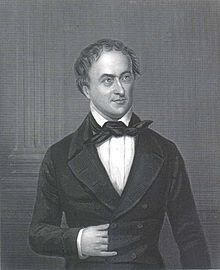Heinrich Rose
Heinrich Rose | |
|---|---|
 Heinrich Rose | |
| Born | 6 August 1795 |
| Died | 27 January 1864 (aged 68) Berlin |
| Nationality | German |
| Known for | rediscovered and naming of niobium |
| Awards | Pour le Mérite (1861) ForMemRS (1842) |
| Scientific career | |
| Doctoral advisor | Jöns Jakob Berzelius |
Heinrich Rose (6 August 1795 – 27 January 1864) was a German mineralogist and analytical chemist. He was the brother of the mineralogist Gustav Rose and a son of Valentin Rose.[1] Rose's early works on phosphorescence were noted in the Quarterly Journal of Science in 1821,[2] and on the strength of these works, he was elected privatdozent at the University of Berlin from 1822, then Professor from 1832.[3]


In 1846, Rose rediscovered the chemical element niobium, proving conclusively that it was different from tantalum. This confirmed that Charles Hatchett had discovered niobium in 1801 in columbite ore. Hatchett had named the new element "columbium", from the ore in which niobium and tantalum coexist. The element was eventually assigned the name niobium by the IUPAC in 1950 after Niobe, the daughter of Tantalus in Greek mythology.[4][5][6][7][8][9][10]
In 1845, Rose published the discovery of a new element pelopium, which he had found in the mineral tantalite.[11] After subsequent research, pelopium was identified to be a mixture of tantalum and niobium.[12]
In 1830, Heinrich Rose was elected a foreign member of the Royal Swedish Academy of Sciences. He was elected to the American Philosophical Society in 1860.[13]
Works
[edit]- Handbuch der analytischen Chemie . Vol.1&2 . Mittler, Berlin 1833–1834 Digital edition by the University and State Library Düsseldorf
References
[edit]- ^ Rammelsberg, Karl Friedrich August (1866). "Biographie: Heinrich Rose". Archiv der Pharmazie. 175 (1–2): 1–19. doi:10.1002/ardp.18661750102. S2CID 221449807.
- ^ The Quarterly Journal, vol 11, no 22, at p.399. See google books.
- ^ "Publication list of Heinrich Rose" (PDF). Archived from the original (PDF) on 2007-06-09. Retrieved 2008-08-31.
- ^ Rayner-Canham, Geoff; Zheng, Zheng (2008). "Naming elements after scientists: an account of a controversy". Foundations of Chemistry. 10 (1): 13–18. doi:10.1007/s10698-007-9042-1. S2CID 96082444.
- ^ Weeks, Mary Elvira (1956). The discovery of the elements (6th ed.). Easton, PA: Journal of Chemical Education.
- ^ Weeks, Mary Elvira (May 1932). "The discovery of the elements. VII. Columbium, tantalum, and vanadium". Journal of Chemical Education. 9 (5): 863. Bibcode:1932JChEd...9..863W. doi:10.1021/ed009p863.
- ^ Weeks, Mary Elvira (1932). "The discovery of the elements: XVI. The rare earth elements". Journal of Chemical Education. 9 (10): 1751–1773. Bibcode:1932JChEd...9.1751W. doi:10.1021/ed009p1751.
- ^ Marshall, James L.; Marshall, Virginia R. (2013). "Rediscovery of the Elements: Columbium and Tantalum" (PDF). The Hexagon: 20–25. Retrieved 30 December 2019.
- ^ Marshall, James L. Marshall; Marshall, Virginia R. Marshall (2013). "Rediscovery of the elements: Niobium and Tantalum" (PDF). The Hexagon: 46–51. Retrieved 8 December 2019.
- ^ Partington, J. R. (June 18, 1964). A History of Chemistry. Vol. 4. London, Toronto, New York: Macmillan International Higher Education. p. 189. ISBN 978-1-349-00554-3.[permanent dead link]
- ^ Rose, Heinrich (1845). "On two new metals, pelopium and niobium, discovered in the bavarian tantalites". Philosophical Magazine. Series 3. 26 (171): 179–181. doi:10.1080/14786444508562692.
- ^ Marignac, M. C. (1866). "Recherches sur les combinaisons du niobium". Annales de chimie et de physique (in French). 4 (8): 7–75.
- ^ "APS Member History". search.amphilsoc.org. Retrieved 2021-01-15.
External links
[edit]- Berlin-Brandenburgische Akademie der WissenschaftenAkademiebibliothek Archived 2007-06-09 at the Wayback Machine, Publication list of Heinrich Rose, Chemist
- 1795 births
- 1864 deaths
- 19th-century German chemists
- Members of the Prussian Academy of Sciences
- Scientists from Berlin
- People from the Margraviate of Brandenburg
- Academic staff of the Humboldt University of Berlin
- Members of the Royal Swedish Academy of Sciences
- Foreign members of the Royal Society
- Recipients of the Pour le Mérite (civil class)
- Rare earth scientists
- Geologists from the Kingdom of Prussia
